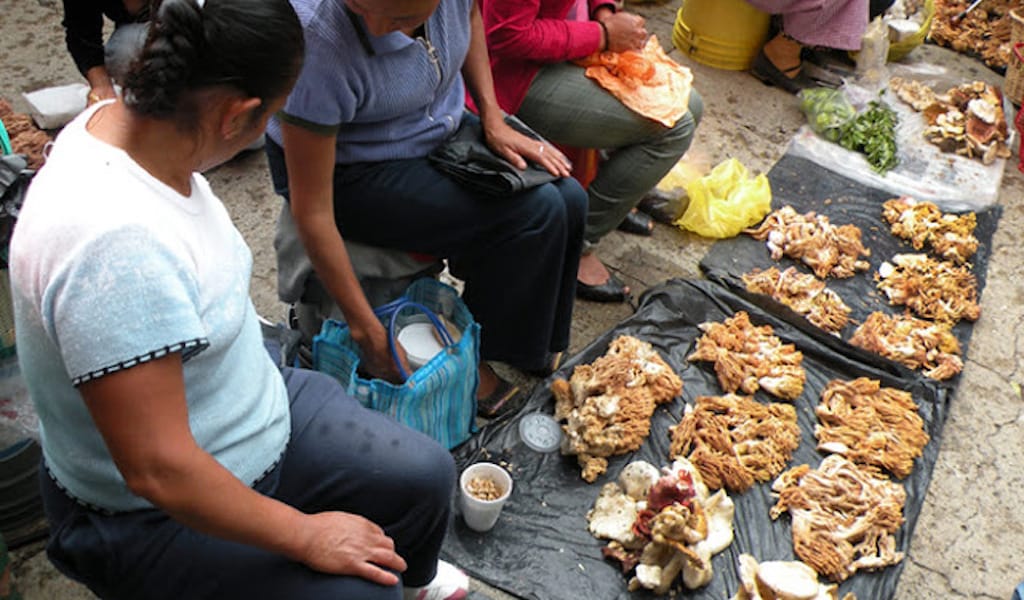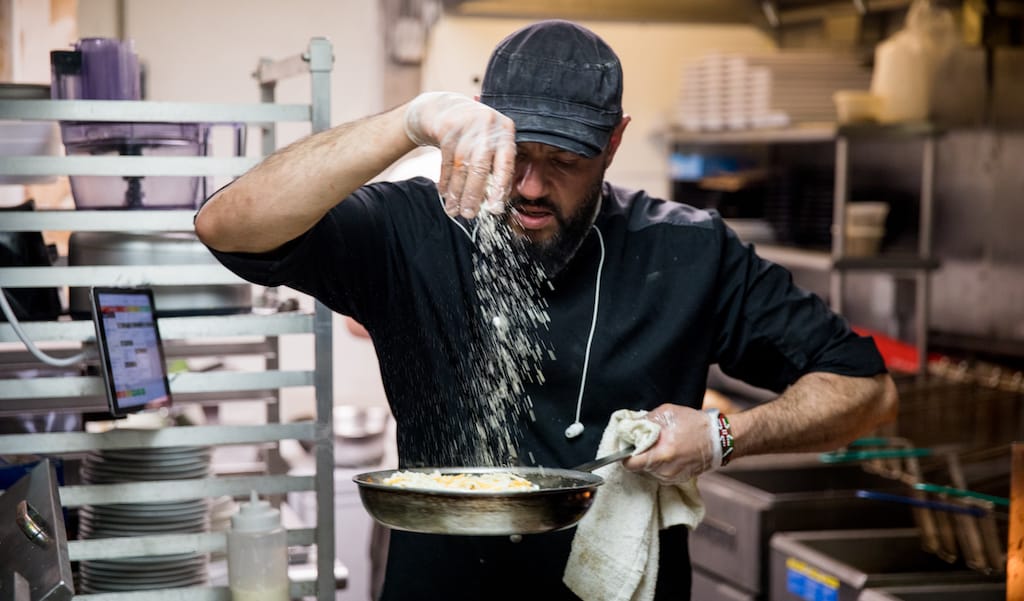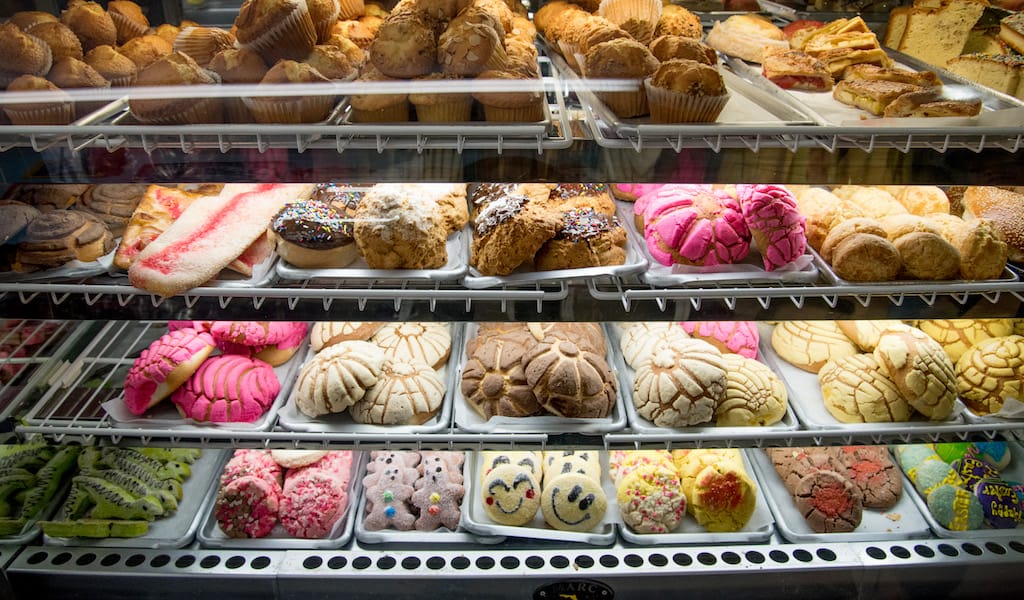In Mexico, the land of eternal spring, something good to eat is always in season. We ravenously await the arrival of artichokes in March, mangos in April, fresh corn in September. Even the wriggly little gusanos de maguey (maguey worms) which appear in May are wildly anticipated – by some. Change in season is subtle here, but essential to the survival of the country. But seasonal lines are blurring. Asparagus rears its tasteless Chilean head all year; pallid strawberries are found in December. Seasons have gone global and our palates suffer for it. Which is all the more reason to pay attention to what’s local now.
From July into October, coinciding with our temporada de lluvia, wild mushrooms, spurred on by rain and humidity, hit the markets of central Mexico. Here in the capital, the month of August is high ‘shroom time.
Most common is huitlacoche (sometimes spelled with a “c”), which is a fungus that grows on corn; it’s dark, blue-black and subtly aromatic, reminiscent of truffles. It is most commonly prepared as a quesadilla filling, sometimes as a sauce for meat or a creamed soup.
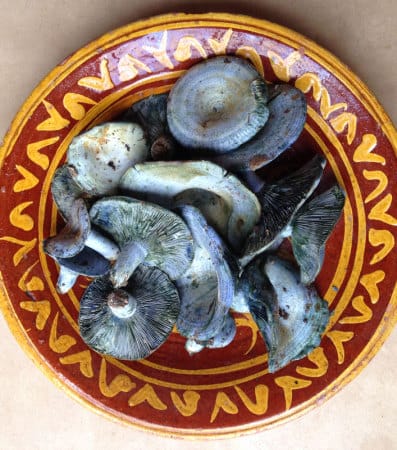 An extraordinary variety of mushrooms are available, mostly culled from the wilds of the states of Mexico, Hidalgo, Morelos and Puebla. Some, like the yellow duraznillos, the fat pambazos or the spongy morillas, correspond exactly to such high-end European treasures as chanterelles, cèpes and morels. No wonder one sees chefs and French expats gleefully scooping up kilos of them at the Mercado San Juan, thrilled to be paying 80 pesos instead of €80.
An extraordinary variety of mushrooms are available, mostly culled from the wilds of the states of Mexico, Hidalgo, Morelos and Puebla. Some, like the yellow duraznillos, the fat pambazos or the spongy morillas, correspond exactly to such high-end European treasures as chanterelles, cèpes and morels. No wonder one sees chefs and French expats gleefully scooping up kilos of them at the Mercado San Juan, thrilled to be paying 80 pesos instead of €80.
The religious and culinary use of hongos has been integral to the culture in Mexico since long before the arrival of the Spaniards. The Mexica even dedicated the deity Nanacatzin as Lord of the Mushrooms.
Much of this culture was later lost, though hallucinogenic specimens are still popular among certain indigenous groups. Gastronomic traditions, however, hang by a thread.
In traditional markets and tianguis where hongos silvestres are sold, country folk are the main customers. While chef/historian Ricardo Muñoz Zurita gives space to over 40 separate varieties in his Enciclopédico de Gastronomía Mexicana, the most we have seen for sale by any given vendor is a dozen, which is an amazing sight to behold. Most wild mushrooms sold here are prepared as traditional Mexican guisados (stews) or in soups or tacos.
For international chefs, the coveted morels are naturally destined for a classic Lyonnais poulet aux morilles. Duraznillos (chanterelles) do nicely in a tart or tossed with butter and fresh pasta. Giant pambazos, straight out of Alice in Wonderland, are best finely sliced and sautéed in olive oil; but gastronomic Europhilia stops here, as many other eye-popping varieties can be had for the price of a torta and should be sampled. Hongos azules, with their worrisome color of stonewashed Levi’s, are not delicious done a la francesa: their guttural bitterness needs to be harnessed in. Witch-like black catrines must be stewed with meat and chiles, as alone they’re not fit for man nor beast.
When buying wild mushrooms, the instructions for preparation as laid out by their seller must be followed to the letter, or the dish will be bound for the trash bin. Merchants (almost always elderly women) will instruct the buyer to stew the mushrooms with a bit of garlic, tomato, epazote and chile al gusto, then serve as a taco or quesadilla filling. Unfortunately, it is difficult to find wild mushrooms already prepared at eating establishments. At street/fonda level, the pickings are slim, mycologically speaking, other than of the aforementioned huitlacoche.
While some renowned local chefs like Eduardo García of Máximo Bistrot, Jared Reardon of Jaso and Jair Téllez of Merotoro take advantage of these gifts of the gods and present seasonal dishes, it is rare to find the traditional Mexican versions offered for public consumption. One traditional fonda, Restaurante Lupita, west of the city, offers quesadillas, hongos de temporada in a roasted foil-wrapped packet and the occasional stew. (Lupita is located in La Marquesa: after entering La Marquesa, it is at km 9. A sign on the right announces “Valle del Potrero”; to the left of the archway are two connected stands – Lupita is the one on the right.) A vendor or two in the market of Amecameca might do an all-blue taco, but we have never seen them anywhere else. The bottom line for mycophiles is that you will have to do it yourself: buy and cook. We’ve ingested a rainbow of fungi and lived to tell the tale. The end of the season is near, so act now!
Where to buy wild mushrooms:
Most tianguis (weekly street markets) are selling wild mushrooms now, such as at Condesa’s Tuesday market on Calle Pachuca, and Polanco’s Saturday market.
Mercado Merced
Along the western side of the main building are several amazing vendors. Take the metro to the Merced stop. Exit at the front end of the train and turn left as you leave – you will be in the main building. Walk straight to the front side, then turn left; walking along the corridor of vendors who line the outside wall, you will see them, towards the end. Prices here are much cheaper than most.
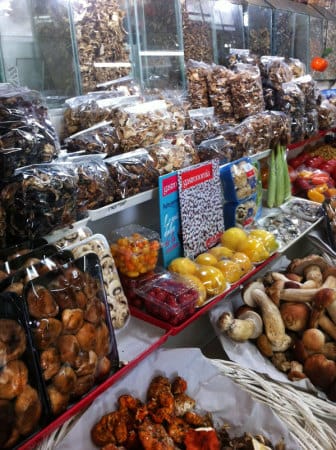 Mercado San Juan
Mercado San Juan
Renowned stand no. 261 (to the left as you enter the market) is run by Hermelinda Guillén Vargas and offers the best in the country, including farmed porcini and shiitake. She has the dried versions year-round. Several other stands have a smaller selection.
Mercado Jamaica
The central flower market south of the Centro Histórico is easy to get to by metro – just get off at the Jamaica stop of lines 4 or 9. Inside the food section are several mushroom sellers.
Mercado Roma
The market is located at Querétaro 225, between Medellín and Monterrey. Rancho El Camino (towards the back on the right) offers a good selection of mushrooms from the state of Mexico.
Editor’s note: It’s Harvest Week at Culinary Backstreets, and we’re sharing some of our favorite stories, past and present, about the harvest. This piece on wild mushrooms in Mexico City was originally published in October 2014.
 May 17, 2019 Addy’s Barbeque
May 17, 2019 Addy’s Barbeque
We hear it, and smell it, before we see it. At Addy's Barbeque in Astoria, every […] Posted in Queens January 14, 2019 Going Deep
January 14, 2019 Going Deep
As the calendar year turns over, we’ve grown accustomed to the barrage of lists telling […] Posted in Naples, Special category February 25, 2019 Save Room for Dessert
February 25, 2019 Save Room for Dessert
On our “Corona’s Culinary Specials” walk in Queens, we make our way along Roosevelt […] Posted in Queens
Nicholas GilmanNicholas Gilman
Published on October 24, 2018
Related stories
May 17, 2019
QueensWe hear it, and smell it, before we see it. At Addy's Barbeque in Astoria, every mishkaki enters the dining room with a sizzle. The style of cooking, let's be clear, isn't the "low and slow" barbeque of the American South. Don't expect smoked beef brisket, which requires hours and hours of cooking, and certainly…
January 14, 2019
Naples | By Culinary Backstreets
NaplesAs the calendar year turns over, we’ve grown accustomed to the barrage of lists telling us where to travel during the next 12 months. Oftentimes these places are a country or even a whole region – you could spend an entire year exploring just one of the locations listed and still barely make a dent.…
February 25, 2019
Queens | By Culinary Backstreets
QueensOn our “Corona’s Culinary Specials” walk in Queens, we make our way along Roosevelt Avenue, ducking into markets and stopping by vendors representing Mexico, Ecuador, and Argentina (among others). On such spot is an Ecuadorian bakery, where the glass cases are filled with a myriad of sweet treats and pastries.







































